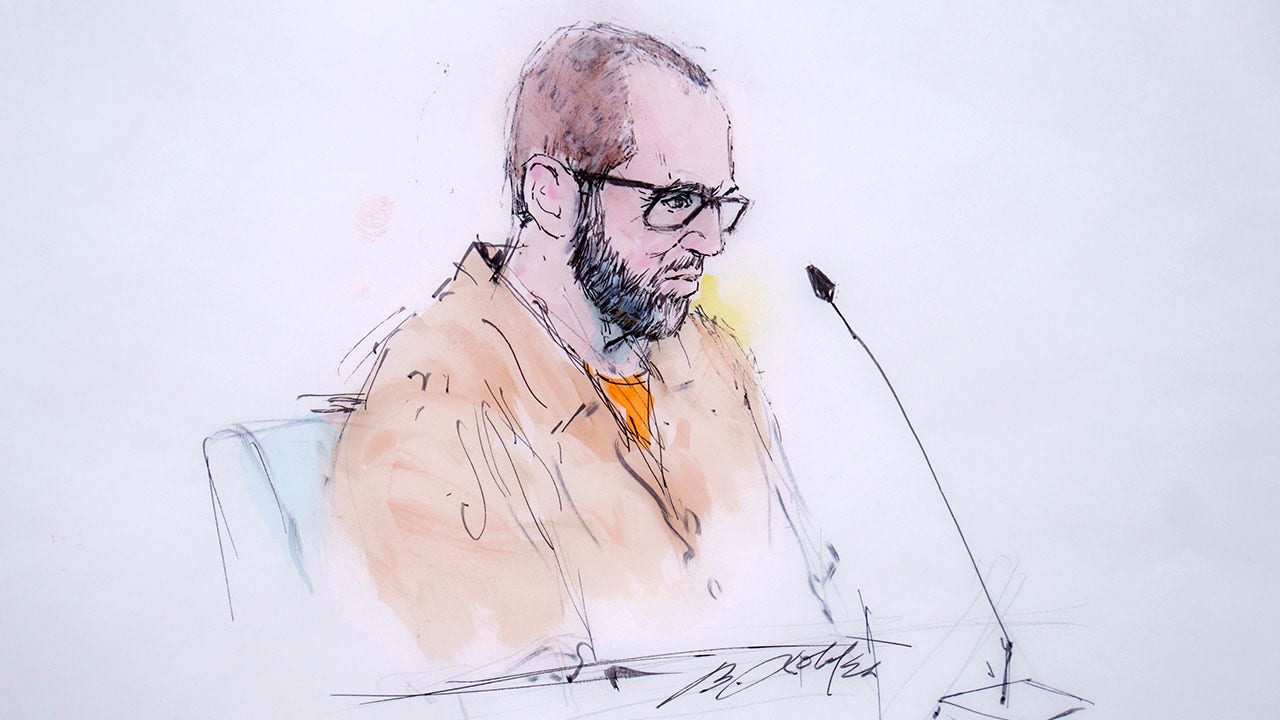Meta’s overhaul of its content moderation and fact-checking policies in the US is bringing into focus a key geopolitical tension likely to grow under the incoming Trump administration: the regulation of speech online.
Technology
Would you buy art from the world’s first humanoid robot artist?
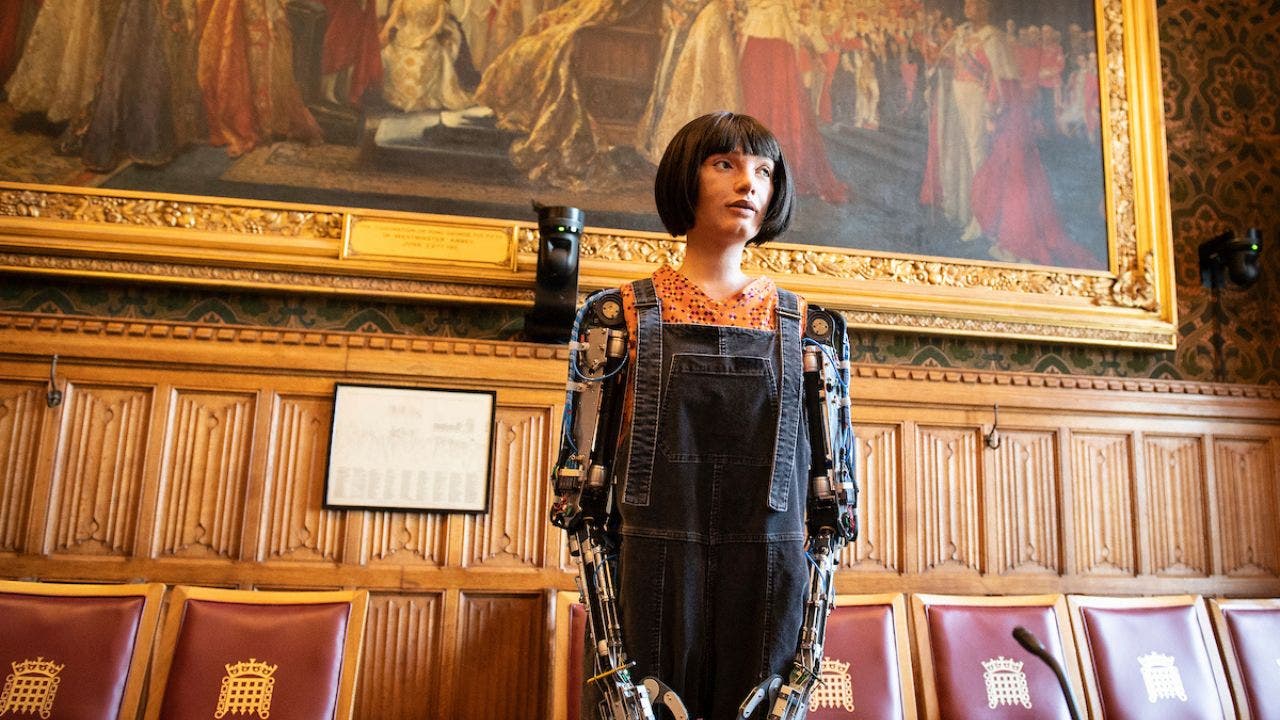
In a groundbreaking moment for the art world, Sotheby’s will auction the first-ever artwork created by a humanoid robot.
Ai-Da, the world’s first ultra-realistic robot artist, has produced a striking portrait of computing pioneer Alan Turing that will go under the hammer this month.
First humanoid robot artist (Ai-Da)
A fusion of art and artificial intelligence
Ai-Da, created in 2019 by British gallerist Aidan Meller, is a marvel of modern technology. Equipped with artificial intelligence algorithms, cameras in her eyes and bionic hands, she can paint autonomously without human intervention. Her latest work, “AI God,” is a 7.2-foot portrait of Alan Turing, estimated to fetch between $130,000 and $196,000.
GET SECURITY ALERTS, EXPERT TIPS – SIGN UP FOR KURT’S NEWSLETTER – THE CYBERGUY REPORT HERE

First humanoid robot artist standing in front of the art she created (Ai-Da)
The significance of the subject
The choice of Alan Turing as the subject is particularly poignant. Turing, a foundational figure in modern computing, also expressed concerns about the potential dangers of artificial intelligence in the 1950s. Meller emphasized that the portrait’s muted tones and fragmented facial planes symbolize the challenges Turing foresaw in managing the rapid growth of AI.
HOW TO REMOVE YOUR PRIVATE DATA FROM THE INTERNET
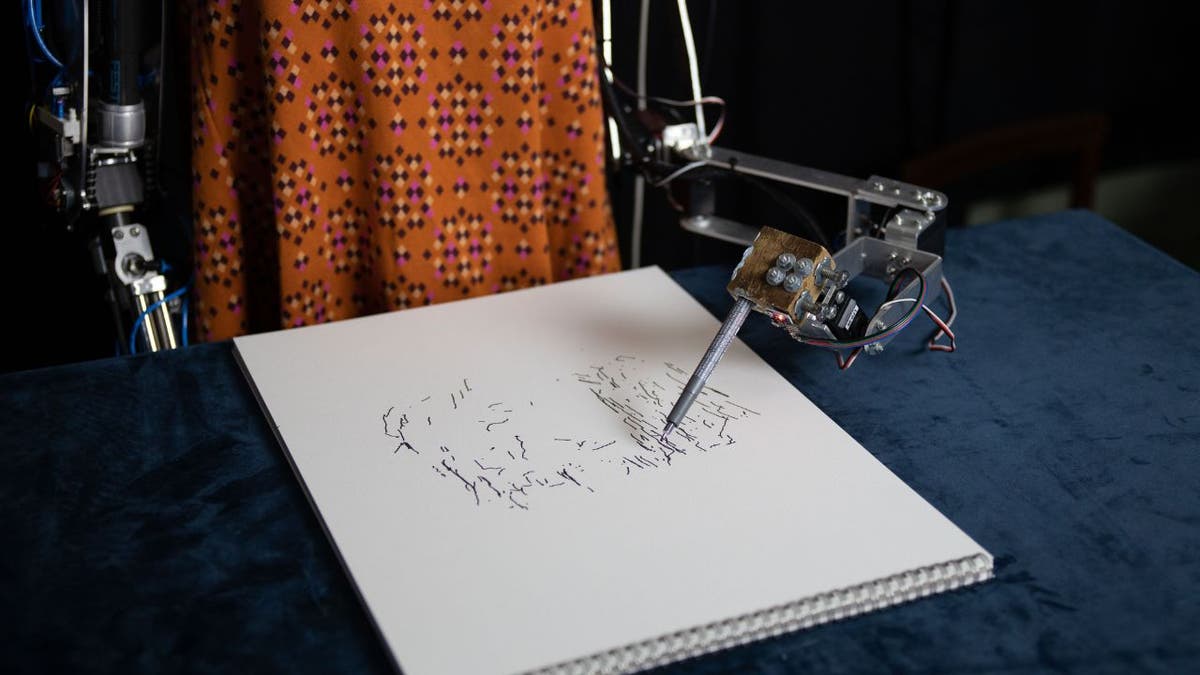
First humanoid robot artist (Ai-Da)
Ai-Da’s artistic journey
The auction for Ai-Da’s portrait of Alan Turing is scheduled for Oct. 31 to Nov. 7. While this may be Ai-Da’s debut at Sotheby’s, it’s far from her first artistic endeavor. Since her first solo exhibition at the University of Oxford, her works have been featured in major exhibitions worldwide, including the Venice Biennale and the United Nations AI for Good Global Initiative. In 2022, she gained attention for painting portraits of music icons like Billie Eilish and Paul McCartney.
WHAT IS ARTIFICIAL INTELLIGENCE (AI)?

The first humanoid robot artist created Paul McCartney art. (Ai-Da)
Blurring the lines of creativity
Ai-Da’s rise comes at a time when the boundaries between human creativity and machine-driven output are increasingly blurred. Her art raises fundamental questions about the nature of artistic expression. Can a machine truly create? What role does human intuition play in art, and how do AI-driven works fit into the larger conversation around creativity?
SUBSCRIBE TO KURT’S YOUTUBE CHANNEL FOR QUICK VIDEO TIPS ON HOW TO WORK ALL OF YOUR TECH DEVICES
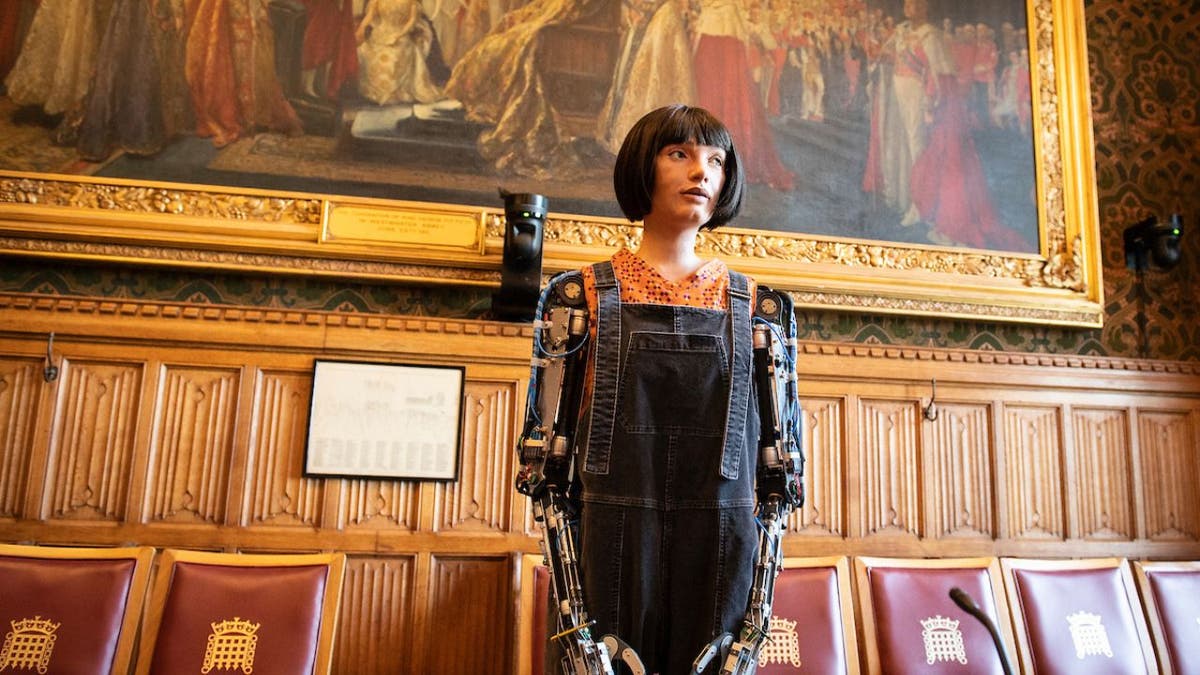
First humanoid robot artist (Ai-Da)
Kurt’s key takeaways
As the art world eagerly anticipates the auction, it’s clear Ai-Da’s work represents more than just a novelty. It’s a pivotal moment that challenges our understanding of art, creativity and the role of AI in society. Whether this marks the beginning of a new era in art or a temporary fascination with AI, Ai-Da has undoubtedly secured her place as a trailblazer in the world of digital art. As we witness this intersection of artificial intelligence and creativity, we’re reminded that the future of art may be more diverse and technologically integrated than we ever imagined.
How do you feel about humanoid robots creating art? Do you see it as a threat to human creativity or an exciting new frontier? Let us know by writing us at Cyberguy.com/Contact
For more of my tech tips and security alerts, subscribe to my free CyberGuy Report Newsletter by heading to Cyberguy.com/Newsletter
Ask Kurt a question or let us know what stories you’d like us to cover
Follow Kurt on his social channels
Answers to the most asked CyberGuy questions:
New from Kurt:
Copyright 2024 CyberGuy.com. All rights reserved.

Technology
Meta is highlighting a splintering global approach to online speech
/cdn.vox-cdn.com/uploads/chorus_asset/file/25822586/STK169_ZUCKERBERG_MAGA_STKS491_CVIRGINIA_A.jpg)
CEO Mark Zuckerberg made no secret of his attempt to align his interests with those of President-elect Donald Trump, saying he planned to work with Trump to “push back on governments around the world that are going after American companies and pushing to censor more” — naming Europe specifically. The US and the European Union have long had different approaches when it comes to digital regulation, which has at times inflamed tensions since many of the largest tech companies that end up being targeted by Europe’s rules are the US’s crown jewels. That dynamic is likely to be exacerbated under a second Trump administration, with the incoming president’s protectionist policies.
“The inflection point is Trump, and Facebook is just following along,” says Daphne Keller, director of the program on platform regulation at Stanford University’s Cyber Policy Center. Through the policy change, Meta is signaling to Trump that “we want to be part of a fight with Europe. We’re on your side. We’re pro-free speech,” she says.
“The inflection point is Trump, and Facebook is just following along”
Meta says the end of its third-party fact-checking program is a change it’s making “starting in the US.” The company is switching from working with third-party fact-checkers to a crowd-sourced Community Notes model, styled after X, along with fewer restrictions on what negative things users can say — particularly about women and LGBTQ people — on their platforms. Zuckerberg says this combined with other content moderation policy changes will make it so less content is inappropriately removed, a common complaint the right has been making for years, even if that means more unsavory (but legal) content stays up longer.
Under Europe’s Digital Services Act, large platforms like Meta can be held accountable for failing to remove illegal content or that which violates their own terms of service in a timely manner once it’s reported, with fines as high as 6 percent of their annual global revenue. Meta says that under its changes, it will still take down illegal content but is loosening its approach on what’s sometimes referred to as “lawful but awful” content, such as likening women to “household objects.”
Even so, should Meta expand its new approach globally, it could run into trouble in Europe. Some digital law experts worry that the DSA’s risk assessment and risk mitigation provisions could be interpreted to compel platforms to remove speech, even if the law doesn’t directly require the removal of certain harmful content. Those parts of the law require platforms to assess risk and create plans to mitigate the potential negative impact of their services on “fundamental rights,” which may be vague enough for some regulators to make the case that content moderation and fact-checking decisions may be included.
Others, like London School of Economics and Political Science associate law professor Martin Husovec, have said that fears that the DSA would turn the EU into a “Ministry of Truth are misplaced,” since even though there’s opportunity for abuse, the law is not “pre-programmed” to suppress lawful disinformation.
European Commission spokesperson Thomas Regnier declined to comment on Meta’s announcement but said in a statement that they will continue to monitor designated “very large online platforms” like Meta for compliance with the DSA. “Under the DSA, collaborating with independent fact-checkers can be an efficient way for platforms to mitigate systemic risks stemming from their services, while fully respecting the freedom of expression,” Regnier says. “This applies to risks such as the spread of disinformation, or negative effects to civic discourse and electoral integrity.”
Regnier also noted that Meta signed the voluntary Code of Practice against disinformation, which includes certain commitments about working with fact-checkers. But it could continue to follow X’s footsteps in reversing that commitment.
During a press conference after Meta’s announcement, Regnier said that Europe isn’t asking any platforms to remove lawful content. “We just need to make the difference between illegal content and then content that is potentially harmful … There, we ask just platforms to take appropriate risk mitigation measures.”
Regardless, Meta will still likely need to remove more speech in Europe than it does in the US to comply with local laws. For example, Holocaust denial is illegal in countries like Germany, while the US has no such speech restrictions. Still, Keller points out that European leaders are less unified now than they were a couple years ago when it comes to dealing with issues like gender identity and immigration. “A bunch of right and far-right parties are coming to power in Europe. So there’s far less of a unified European political agenda around culture wars issues than there used to be,” she says.
Even so, Keller says she worries that Zuckerberg’s rhetoric toward Europe in his announcement could create a dynamic that emboldens European regulators who want to go after US platforms over speech concerns. “He will offend them, and they’ll get their backup, and then they really will interpret it to give themselves broader powers and to be able to punish Meta more,” Keller says. “It’s almost like he’s going to drive them into becoming the censors that he claims they are now.”
Technology
Meta makes major move back to free speech and ends 3rd-party fact-checking program
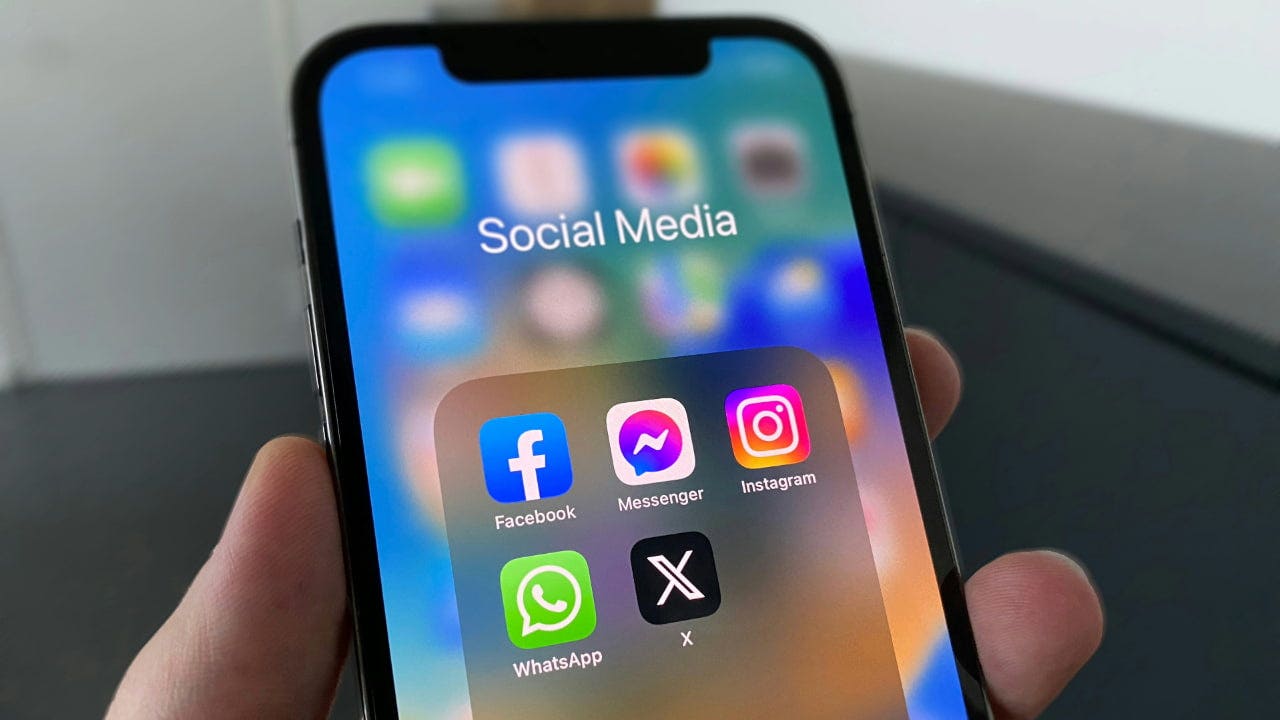
In 2022, Elon Musk acquired Twitter and made a series of changes to the platform, including changing its name to X and introducing Community Notes, which is a feature that allows users to add context or fact-check potentially misleading posts.
This approach differs from Meta’s model, which relies on third-party, independent fact-checking organizations to flag misleading posts on Instagram, Facebook and Threads (its rival to X).
However, CEO Mark Zuckerberg recently announced that Meta will stop working with these organizations and instead implement an X-like Community Notes feature. Zuckerberg also revealed a series of other major changes to the company’s moderation policies and practices, aimed at offering people more freedom of expression.
I’M GIVING AWAY THE LATEST & GREATEST AIRPODS PRO 2
Meta’s logo (Kurt “CyberGuy” Knutsson)
Community Notes coming to Meta platforms
Zuckerberg announced Tuesday that the social media company would stop working with third-party fact-checking organizations. In a video posted on Instagram and Facebook, Zuckerberg said the company’s content moderation approach resulted too often in “censorship.”
“After Trump first got elected in 2016, the legacy media wrote nonstop about how misinformation was a threat to democracy. We tried in good faith to address those concerns without becoming the arbiters of truth,” Zuckerberg said. “But the fact-checkers have just been too politically biased and have destroyed more trust than they’ve created, especially in the U.S.”
Zuckerberg said that Meta will end its fact-checking program with trusted partners and replace it with a community-driven system similar to X’s Community Notes.

For the unaware, Community Notes on X allows users to collaboratively add context or fact-check potentially misleading posts. When a tweet is flagged for misinformation or lack of context, users can submit notes that provide additional information or correct inaccuracies.
These notes are then reviewed by other users, who can upvote or downvote the contributions based on their helpfulness and accuracy. If a note receives enough support, it becomes visible beneath the original tweet, offering a balanced view and helping to inform others.
HOW TO PROTECT YOURSELF FROM SOCIAL MEDIA SCAMMERS
Meta’s changes spark backlash from fact-checking community
Independent fact-checkers, however, aren’t happy with the change.
“Fact-checking journalism has never censored or removed posts; it’s added information and context to controversial claims, and it’s debunked hoax content and conspiracy theories. The fact-checkers used by Meta follow a code of principles requiring nonpartisanship and transparency,” said Angie Drobnic Holan, director of the International Fact-Checking Network.
WHAT IS ARTIFICIAL INTELLIGENCE (AI)?

Social media apps on an iPhone’s home screen (Kurt “CyberGuy” Knutsson)
HOW TO PROTECT YOUR FACEBOOK ACCOUNT FROM HACKERS
Meta is also reducing censorship
Zuckerberg also revealed plans to overhaul Meta’s recommendation system, which determines the content shown to users. For years, the company has restricted political content, citing user feedback and concerns about the impact of social media on beliefs.
“We built a lot of complex systems to moderate content, but the problem with complex systems is they make mistakes,” Zuckerberg said. “Even if they accidentally censor just 1% of posts, that’s millions of people, and we’ve reached a point where it’s just too many mistakes and too much censorship.”
He added that Meta would eliminate some content policies on controversial issues, including immigration and gender, and refocus its automated moderation on what he described as high-severity violations. The company will now take a more personalized approach to political content so that people who want to see more of it in their feeds can see it.
In addition, Facebook will relocate its trust and safety and content moderation teams from California to Texas. Zuckerberg also said Meta would collaborate with the incoming Trump administration to promote free speech globally, though he did not provide specific details.
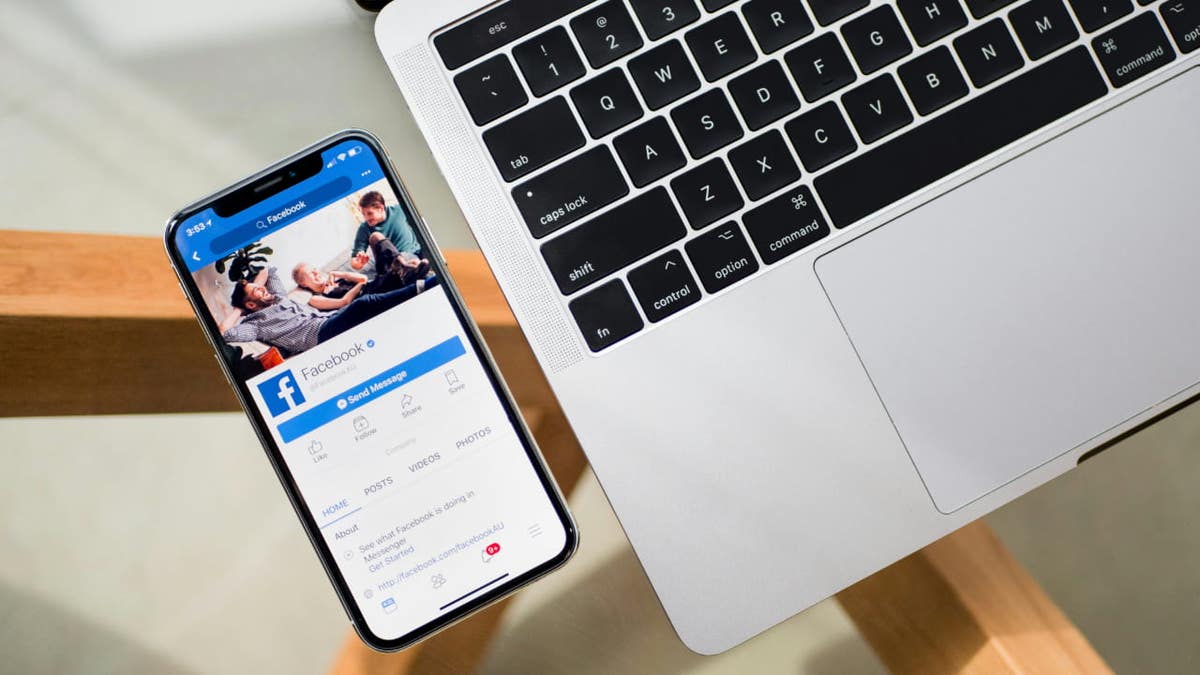
Facebook app on an iPhone (Kurt “CyberGuy” Knutsson)
FACEBOOK AND INSTAGRAM ARE USING YOUR DATA TO TRAIN AI: LEARN HOW TO PROTECT YOURSELF
Kurt’s key takeaway
Meta’s platforms, like Facebook and Instagram, have been more tightly moderated compared to platforms like X, which has meant less freedom of expression for users. The changes Zuckerberg announced on Tuesday aim to relax those rules, letting people share their thoughts more freely. This could lead to more offensive content, but that’s the trade-off for more freedom. The introduction of Community Notes is a good change, too, as it gives users more control instead of leaving it to a small group of people who might be biased toward a certain political party or issue.
What do you think about the changes Zuckerberg is making to Meta’s content moderation? Let us know by writing us at Cyberguy.com/Contact.
For more of my tech tips and security alerts, subscribe to my free CyberGuy Report Newsletter by heading to Cyberguy.com/Newsletter.
Ask Kurt a question or let us know what stories you’d like us to cover.
Follow Kurt on his social channels:
Answers to the most asked CyberGuy questions:
New from Kurt:
Copyright 2025 CyberGuy.com. All rights reserved.
Technology
Apple says Siri isn’t sending your conversations to advertisers
/cdn.vox-cdn.com/uploads/chorus_asset/file/24401980/STK071_ACastro_apple_0003.jpg)
The section specifically responding to the rumors reads:
Apple has never used Siri data to build marketing profiles, never made it available for advertising, and never sold it to anyone for any purpose. We are constantly developing technologies to make Siri even more private, and will continue to do so.
After The Guardian’s report in 2019, Apple apologized and changed its policy, making the default setting not to retain audio recordings from Siri interactions and saying that for users who opt-in to sharing recordings, those recordings would not be shared with third-party contractors.
However, reports about the settlement noted that in earlier filings like this one from 2021, some of the plaintiffs claimed that after they mentioned brand names like “Olive Garden,” “Easton bats,” “Pit Viper sunglasses,” and “Air Jordans,” they were served ads for corresponding products, which they attributed to Siri data.
Apple’s statement tonight says it “does not retain audio recordings of Siri interactions unless users explicitly opt in to help improve Siri, and even then, the recordings are used solely for that purpose. Users can easily opt-out at any time.”
Facebook responded to similar theories in 2014 and 2016 before Mark Zuckerberg addressed it directly, saying “no” to the question while being grilled by Congress over the Cambridge Analytica scandal in 2018.
So, if Apple (and Facebook, Google, etc.) is telling the truth, then why would you see an ad later for something you only talked about?
There are other explanations, and attempts to check the rumors out include an investigation in 2018 that didn’t find evidence of microphone spying but did discover that some apps secretly recorded on-screen user activity that they shipped to third parties.
-

 Business1 week ago
Business1 week agoThese are the top 7 issues facing the struggling restaurant industry in 2025
-

 Culture1 week ago
Culture1 week agoThe 25 worst losses in college football history, including Baylor’s 2024 entry at Colorado
-

 Sports1 week ago
Sports1 week agoThe top out-of-contract players available as free transfers: Kimmich, De Bruyne, Van Dijk…
-

 Politics7 days ago
Politics7 days agoNew Orleans attacker had 'remote detonator' for explosives in French Quarter, Biden says
-

 Politics6 days ago
Politics6 days agoCarter's judicial picks reshaped the federal bench across the country
-

 Politics5 days ago
Politics5 days agoWho Are the Recipients of the Presidential Medal of Freedom?
-

 Health4 days ago
Health4 days agoOzempic ‘microdosing’ is the new weight-loss trend: Should you try it?
-

 World1 week ago
World1 week agoIvory Coast says French troops to leave country after decades












